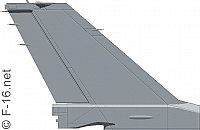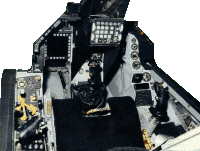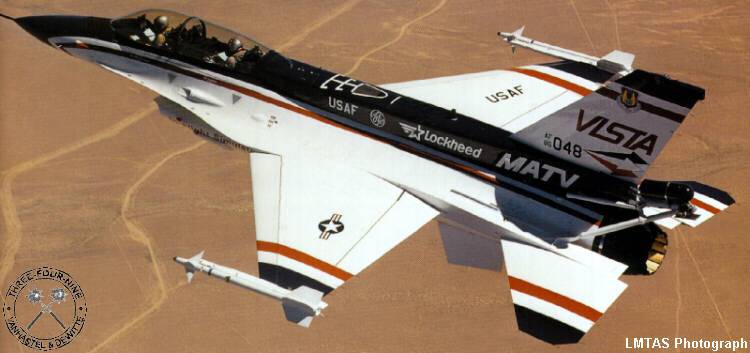 |
F-16 VISTA / MATV / NF-16DVariable-stability In-flight Simulator Test Aircraft, Multi Axis Thrust Vectoring |
History
Start-and-stop beginning of the MATV
The F-16 Multi-Axis Thrust-Vectoring (MATV) program originally began as a joint General Electric/General Dynamics privately-funded program for a thrust-vectored version of the Fighting Falcon. The USAF initially declined to support the program, so the two companies agreed to collaborate with the Israel Defense Force/Air Force, which was highly interested in the program for its own F-16s.
Under the terms of the agreement, the IDF/AF was to supply a F-16D for the tests, with the two American companies doing the conversion. However, in 1991 the USAF's Wright Laboratory became interested in the project, and the USAF now assumed an active role. Israel withdrew from the program in 1992.
The USAF's TAC loaned the Lockheed Fort Worth Company (LWFC) a F-16D block 30 (#86-0048) to be modified into a thrust vectoring research aircraft. The modified Lockheed F-16 variable stability in-flight simulator test aircraft (VISTA) flew five times in 1992 and was then placed in flyable storage because of a lack of funding.
VISTA program
In 1988, a contract was awarded to General Dynamics, Fort Worth Division to develop the VISTA (Variable stability In-flight Simulator Test Aircraft). Calspan, a subcontractor to GD, installed a center stick and integrated the computers needed to perform variable stability flights. Wright Labs bought the aircraft in 1988 and from 1988 until 1992, the VISTA/F-16 program was being accomplished. There was no connection between thrust vectoring and VISTA/F-16 at this time.

The sidestick is over on the console, while the center stick is mounted on a short pedestal between the pilot's knees. The upfront controller had to be remove to put the center stick in, but since the VISTA is a research plane and not a fighter, the loss was acceptable. Both sticks can be either force or motion sticks, with complete control of force gradients, shaping and range of motion.
Three Rolm hawk computers, mounted in the aircraft's dorsal fin, provide the variable stability functions and make VISTA an in-flight simulator. The computer system monitors the pilot's inputs and then moves the aircraft's control surfaces to produce the required motions. The controls to access the computer to change flight characteristics and engage the front seat controls are mounted in the back seat. The Variable Stability System (VSS) commands symmetric and asymmetric horizontal tail movement, symmetric and asymmetric flaperon movement, rudder and throttle control. The only surfaces not controlled by the VSS are the leading edge flaps and speedbrakes.
Other modifications included in the VISTA configuration include heavy weight landing gear and a larger capacity hydraulic pump and lines to accommodate the increased surface motions needed to simulate other aircraft.
The program objectives itself included the demonstration of the tactical utility of thrust vectoring in close-in air combat and in the use of integrated control of thrust vectoring in flight. The aircraft has demonstrated a steady angle of attack of as much as 86 degrees and a transient angle of attack of up to 180 degrees. In other words, the aircraft can fly BACKWARDS for a brief time. Thrust vectoring provides a significant advantage in terms of bringing armament to bear on a threat more quickly and in avoiding the risk of departure from controlled flight during violent maneuvers. However, the use of really high AoA maneuvers should only be a last-ditch operation in aerial combat in view of the increased vulnerability of the aircraft when it is in a low-energy state.
MATV program
The variable stability computers and the centerstick were temporarily removed from the VISTA for the MATV program, which began flight tests in July, 1993. The aircraft performed six functional flights at the Fort Worth facility in early July and was then ferried to Edwards AFB on March 15th. The remainder of the rigorous flight tests occurred over there and thrust vectoring in flight was first used on July 30th. This Multi-Axis Thrust-Vectoring program compromised the investigation of high angle of attack flights above 20,000 feet. The variable stability computers were put back in place when the MATV program was concluded in March, 1994. In January 1995 it returned to Fort Worth before being flown to Wright-Patterson AFB where it was delivered to the Air Force. Over 130 flight hours have been accumulated with 95 missions.
AVEN program

The heart of the VISTA is its Axisymmetric Vectoring Exhaust Nozzle (AVEN), which is attached to the exhaust of the aircraft's General Electric F110-GE-100 engine. The AVEN achieves the required thrust vectoring within the divergent (supersonic flow) portion of the nozzle, which prevents pressure fluctuations from being fed back into the engine where they could cause a compressor stall. The divergent flaps are angled individually by means of a ring that is positioned by three additional hydraulic actuators located at 120-degree intervals, with power being supplied by an independent system.
The exhaust nozzle can be deflected in any direction through an angle of up to 17 degrees. Axial and side forces imposed by the jet exhaust on the nozzle are transferred into the jetpipe and thus back into the engine. The advantage of the AVEN is that it could be retrofitted to any F-16 that was powered by the F110 engine and which had a digital flight control system.
The movement of the three actuators is commanded by a Vector Electronic Control (VEC), which is a modified version of the full-authority digital engine control used by the F110-GE-129 engine. In order to counterbalance the additional weight of the AVEN, the weight of the spin chute and the hardware (which is quite heavy), 700 pounds of ballast were added on the inlet hardpoints to keep the center of gravity ahead of 38% chord in order to avoid the danger of deep stalls should the thrust vectoring system fail. As an additional safety measure, a spin-recovery parachute was installed high over the rear end of the aircraft to assist in recovery from deep stalls should they occur.
Multi-directional thrust-vectoring program
A multi-directional thrust-vectoring nozzle and the Pratt & Whitney PYBBN configuration of the F100-PW-229 engine have been installed on the NF-16D. The nozzle-engine combination, designed and produced by P&W, has a fail-safe dual-redundant actuation system. The axisymmetric nozzle features full 360-degree thrust vectoring at a maximum deflection angle of twenty degrees. The nozzle is adaptable and fits any model F100 engine.
A six-month flight test program with this engine-airframe combination was to be conducted in 1997 and the Air Force and Calspan would have the aircraft ready for customers in 1998. However, the P&W thrust vectoring program has been canceled. The aircraft was converted to use a standard F100-PW-229 engine and was delivered back to Calpsan (the aircraft operators)in June of 1997.
The center stick was installed by GD, not Calspan.............I'm the engineer that performed the engineering. This installation included a hydraulically powered artificial feel system.
The stick was removable since it was a concern for ejection envelope issues.
The NF-16D Vista has now been designated X-62A.
The PYBBN engine was never installed in 048, the only 2 PYBBN engines remain in the F-15 ACTIVE on display at Armstrong Flight Research Center.
Please use this form to add any list any error or omissions you find in the above text.
Note: your comments will be displayed immediately on this page. If you wish to send a private comment to the webmasters, please use the Contact Us link.
